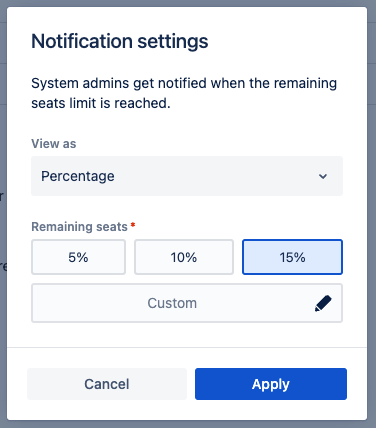Health Check: Jira license limit
Platform Notice: Data Center - This article applies to Atlassian products on the Data Center platform.
Note that this knowledge base article was created for the Data Center version of the product. Data Center knowledge base articles for non-Data Center-specific features may also work for Server versions of the product, however they have not been tested. Support for Server* products ended on February 15th 2024. If you are running a Server product, you can visit the Atlassian Server end of support announcement to review your migration options.
*Except Fisheye and Crucible
There's currently a bug affecting this health check for unlimited user licenses in ATST 1.58.0
If you have an unlimited user license for either Jira Software or Jira Service Management and see this health check failing, please upgrade to ATST 1.59.0+. Alternatively, you may safely disable the health check for that application.
Purpose
The Jira Software license limit and Jira Service Management license limit health checks test if you are approaching your license limit in Jira Software and Jira Service Management. The health checks will only be visible when that application is licensed on your instance. These checks can be used as an early indicator to ensure you don't exceed your license limit.
Understanding the results
Result | What this means |
|---|---|
| Your [Jira Software / Jira Service Management] instance has not reached its warning limit of [warning limit] remaining seats. | Your instance is below the warning limit. Note that the default warning limit is set to 10%, but you can change this to a different percentage, or to the number of remaining seats. |
Your [Jira Software / Jira Service Management] instance has reached its warning limit of [warning limit] remaining seats. To prevent your instance exceeding the user limit, you can:
| You are approaching your license limit. If you exceed the limit your instance may be put into read-only mode where users will not be able to create issues. |
Resolution
This check does not indicate an immediate problem on your instance. Instead it's a warning that the user count for an application is approaching the license limit. If you exceed the license count allowed by your Jira application license, your users will not be able to create issues.
To avoid exceeding your licence limit you can upgrade your license or reduce your user count.
If you don’t want to see the message, you can also change the limit for this notification or disable the health check.
Reducing your user count
The recommended method for reducing your user count in Jira is to remove users from the groups associated with the application. A user may be a member of multiple groups, but will only count as one user on your license. See managing users for more information.
Alternatively, if you have connected Jira to an LDAP directory, you may want to configure Jira to synchronize a subset of users from LDAP rather than all users. See Reducing the number of users synchronized from LDAP to Jira applications for more information. However, this can be a complicated procedure and we recommend that you do not use this method unless necessary.
Changing the limit for the health checks
The limit for these checks can be configured via the UI (from ATST 2.3.0) or a REST API.
Changing the limit via the UI ATST 2.3.0
Health checks are stored in the admin area, so make sure you are logged in with access to the Atlassian troubleshooting and support tools admin tab to change the license limit notification. Any changes you make to the limit are tracked in the audit log.
Go to the Instance health tab in Troubleshooting and support tools.
Make sure that the software license limit is enabled (see how to toggle this on and off).
Click the Edit notification trigger amount link.
This will open a modal where you can set the limit as either a percentage or a fixed number of seats.Click the Apply button to save the limit for that health check.
Changing the limit with the REST API
Authorization
We recommend that your REST API calls are authorized with a personal access token. To do this you should first set up a personal access token. Replace <personal access token> in the requests below with the personal access token you generated. Only system admin accounts will have access to these endpoints.
Viewing the configuration
To view configuration for a health check from the command line:
curl -s -X GET \
-H 'Authorization: Bearer <personal access token>' \
<base url of your instance>/rest/troubleshooting/1.0/license-limit-check/<jsw|jsm>/config{
"limit": 10,
"isPercentage": true
}The limit is the current limit and isPercentage determines whether the limit represents a percentage of remaining seats (true) or a fixed number of remaining seats (false). For example the response above indicates that the health check will fail when there are less than 10% seats remaining.
Setting the configuration
To modify the configuration for a health check from the command line:
curl -s -X PUT \
-H 'Authorization: Bearer <personal access token>' \
-H "Content-Type: application/json" \
<base url of your instance>/rest/troubleshooting/1.0/license-limit-check/<jsw|jsm>/config \
-d '{"limit": 5, "isPercentage": true}'For example, the command above sets the limit to 5%. This will cause the health check to fail when there are less than 5% seats remaining for that application (Jira Software or Jira Service Management).
If successful it will respond with a 200 response code and an empty body.
You will then see the updated limit in the UI on the troubleshooting and support tools page.
Disabling this notification
You can disable these health checks by disabling the ‘Enable this check’ toggle for the check on the Troubleshooting and support tools settings page under the ‘Instance health’ tab.



